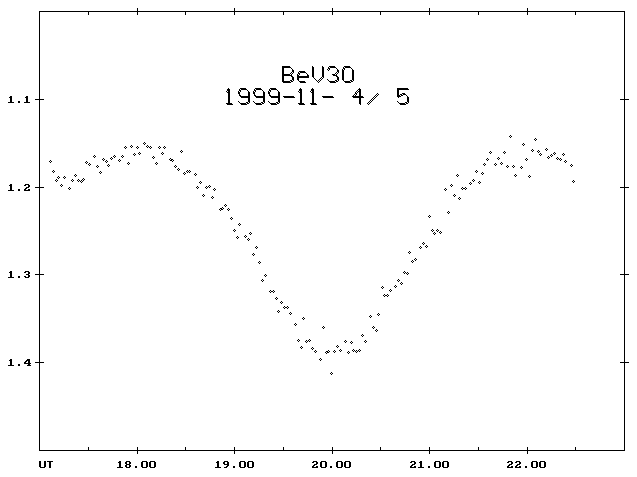IBVS-Veröffentlichung
in 2001
Elemente von Brh V30
Nach dem momentanen Kenntnisstand vom 12.12.1999 und der Annahme,
das es sich um einen Bedeckungsstern (wahrscheinlich EW) handelt, gehen
wir von folgenden vorläufigen Elementen aus:
Min I = HJD
2451487,245 + 0,34236 d * E
Die Gesamtlichtkurve zeigt, das noch nicht alle
Bereiche der Phase
abgedeckt sind und noch dringender Beobachtungsbedarf besteht!
Nachricht von Chris Lloyd - 7.12.1999
Just a quick note about Brh V30. I've put the data through the period
analysis and come up with 0.17115 days (beta Cep or similar) or twice
that (for WUMa type). This period is the 1-day alias of the period I
suggested before. If you plot up the data using the longer period you can
see that parts of the light curve are not well covered, so for any future
observations these are the places to aim for.
Brh V30 = GSC 1172:1452
Von: Klaus Bernhard [klaus.bernhard@vpn.at]
Gesendet: 30. Oktober 1999 15:40
I would like to send you observations of a new variable star (BeV30),
which I have discovered in a systematic CCD-based search for new variables.
In each observing run typically 400 images are taken of several survey fields.
The frames are processed automatically.
Instruments:
CCD-camera:Starlight Xpress SX (unfiltered)
Telescope: Celestron-8 (20 cm Schmidt-Cassegrain)
New variable star:
new Brh V30 233232.6 N103320 (J2000) 12.1 12.4(CCD)
Comparison star was for all measurements GSC 1172 1385 (11.7 mag),
which was checked to be constant.
Data analysis was made by Chris Lloyd, UK. His comment:
Strong series of periods increasing towards higher frequency. The
best period is 0.2065 days so it may be a beta Cep or delta Sct, or
something similar.
object YYMMDD(UT) mag (CCD) code
BeV30 990911.0056 12.19 BRH.BAV
BeV30 990911.9972 12.22 BRH.BAV
BeV30 990912.9979 12.28 BRH.BAV
BeV30 990913.9896 12.42 BRH.BAV
BeV30 990915.0201 12.40 BRH.BAV
BeV30 990923.9632 12.28 BRH.BAV
BeV30 990927.9556 12.20 BRH.BAV
BeV30 991002.0451 12.12 BRH.BAV
BeV30 991007.9291 12.43 BRH.BAV
Regards,
Klaus Bernhard

Aktuelle Lichtkurve von Wolfgang Moschner
vom 4./5. November 1999 = JD 2451487

Vergleichsstern = GSC 1172:1483
Die
Periode für einen pulsierenden Stern läge bei ca. 0.24 d und für einen
Bedeckungsveränderlichen bei 0.48 d. Es handelt sich um eine provisorische
Ableitung
aus den Meßpunkten diesen Abends. Erst weitere Messungen werden eine brauchbare
Periode für erste Elemente ergeben. Originalmeßpunkte nicht bearbeitet.
RC-Teleskop d= 320 mm f= 1740 mm SBIG ST-6 ohne Filter
